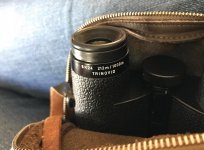I was wondering how well the old Japanese extra wides might fit the original poster's requirements. Birdforum member elkcub has an 8x40 with a stonking field of view, but most seem to be 7x35. 7x seems more useful to me than say 4 or 5x as soaring raptors will often rise to heights of a few thousand feet. If your targets are over a half mile away and that distance up in the sky, they may be very difficult to see or identify with a 4 or 5x.
These wide field devices were produced by a fair number of JB companies and sold under quite a few different brand names, but my experience of this type of binocular is limited to the Swift 7x35 Holiday mark II (field of view given as 578 ft - a later version of this binocular extended the field of view to, I believe, 600 feet). The daddy of this class of binoculars, by most accounts, appears to be the Bushnell 7x35 Rangemaster which at least one person who has commented in this thread owns. I didn't attempt to verify the stated field of view of the Swift I tried, but when I compared it against land marks alongside the Minolta 7x35 MK Standard I owned at the time I found it had a wider field. This particular example just needed to focus a trifle further beyond infinity for observing really distant targets without glasses (my prescription is around 4.5/5). I think most were only single-coated, but light transmission percentages won't be as critical under midday soaring conditions. Eye relief will be too short for glasses/spectacles to be used, but when scanning the sky for distant targets you'll probably be looking through your binoculars almost all the time. If the original poster doesn't need glasses, of course, he's in luck!
I have seen some recommendations for the 7x42 Dialyt for hawk watching with its field of view (150m at 1000m) cited as a key reason, and these wide field 7x35s exceed that by quite a bit. Because my own observation involves trying to follow the birds I am after once they are found, and since they may range so far away, I now prefer 10x or higher magnification for observing over long distances. But the wide field and steadiness of the 7x magnification make those 7x35 extra wides and indeed the 7x42 a real pleasure to use. My main use for this type of binocular now is observing flocks under attack, where the wider field of view allows more of the action to be seen (in theory anyway).






